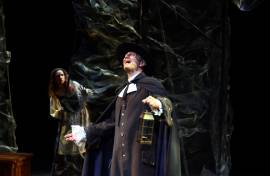
When last we saw her in Arthur Miller’s The Crucible, teen temptress Abigail Williams was about to flee Salem, Massachusetts and its infamous witch trials, leaving in her wake twenty hanged (or otherwise executed) victims of her venomous, vile, trumped-up accusations.
Playwright Roberto Aguirre-Sacasa now imagines Abby’s life ten years later, and fascinatingly so, in Abigail/1702, a play and production no Crucible lover will want to miss, and the latest from Long Beach’s International City Theatre.
 Though ace director caryn desai does provide a convenient “Abigail/1692” program synopsis, it does help to have seen or read the Miller original, not only for Abigail’s back story but to appreciate how skillfully Aguirre-Sacasa has replicated the King James Bible speech patterns that any Crucible buff will recognize tout de suite.
Though ace director caryn desai does provide a convenient “Abigail/1692” program synopsis, it does help to have seen or read the Miller original, not only for Abigail’s back story but to appreciate how skillfully Aguirre-Sacasa has replicated the King James Bible speech patterns that any Crucible buff will recognize tout de suite.
Abigail/1702’s brief prologue reminds us of the circumstances surrounding Abigail’s hasty departure from Salem, then flashes forward to the no-longer-fifteen vixen’s new, reformed life in Boston as a redubbed Ruth Meadow.
Much of Abigail/Ruth’s rebirth is a result of what we now call “community service,” her apprenticeship with a Boston midwife having led to the greater part of a decade spent caring for victims of the dreaded small pox, a childhood bout of which has left her fortunately immune to the then prevalent disease.
 Given Abby Williams’ history—her torrid affair with onetime employer John Proctor was after all the catalyst for the Salem Witch Trials and John’s eventual hanging—and Ruth’s now ten-year-long efforts to live life on the straight and narrow, Abigail/1702’s initial resistance to taking in hunky pox sufferer John Brown is understandable, especially since the sailor’s rather generic name suggests a secret or two buried in his closet as well.
Given Abby Williams’ history—her torrid affair with onetime employer John Proctor was after all the catalyst for the Salem Witch Trials and John’s eventual hanging—and Ruth’s now ten-year-long efforts to live life on the straight and narrow, Abigail/1702’s initial resistance to taking in hunky pox sufferer John Brown is understandable, especially since the sailor’s rather generic name suggests a secret or two buried in his closet as well.
 Still, Ruth’s desire to help those in need does prevail, and she is soon doing her best to insure her newest patient’s survival via the skillful application of leeches and poultices, her efforts proving such a success that before long John is revealing the shirtless torso of a Michelangelo sculpture and awaking feelings and desires Abigail had sworn off in becoming Ruth.
Still, Ruth’s desire to help those in need does prevail, and she is soon doing her best to insure her newest patient’s survival via the skillful application of leeches and poultices, her efforts proving such a success that before long John is revealing the shirtless torso of a Michelangelo sculpture and awaking feelings and desires Abigail had sworn off in becoming Ruth.
Will Abigail/Ruth continue to seek redemption in the doing of good deeds, will she fall victim to her baser desires, or will true love prove her salvation?
Roberto Aguirre-Sacasa not only tackles all of these questions in his latest play, he has the smarts to hold off on answering its biggest question—will its heroine find forgiveness or damnation—until Abigail/1702’s final, powerful moments.
 A couple of key Crucible characters make appearances along the way, one of whom provides Abigail/1702 with its most satisfying scene, a reunion of former rivals with the fate of a child at stake.
A couple of key Crucible characters make appearances along the way, one of whom provides Abigail/1702 with its most satisfying scene, a reunion of former rivals with the fate of a child at stake.
As to whether or not the cagily named Man In Gray is in fact who he claims to be, or a mere figment of Ruth’s imagination, only playwright Aguirre-Sacasa (whose oeuvre just happens to include the campy gay comedy Say You Love Satan) knows for sure.
 Under desai’s assured, nuanced direction, a cast of five do all-around outstanding work on the ICT stage, beginning with a stunning Jennifer Cannon as Ruth. Not only does Cannon reveal a Shakespearean’s ease with archaic language, she digs deep into a profoundly complex young woman in a mesmerizing performance that has her never once leaving the stage. (Abigail’s flashback monolog recalling the Indian attack that left her her family’s—and her village’s—sole survivor is particularly riveting.)
Under desai’s assured, nuanced direction, a cast of five do all-around outstanding work on the ICT stage, beginning with a stunning Jennifer Cannon as Ruth. Not only does Cannon reveal a Shakespearean’s ease with archaic language, she digs deep into a profoundly complex young woman in a mesmerizing performance that has her never once leaving the stage. (Abigail’s flashback monolog recalling the Indian attack that left her her family’s—and her village’s—sole survivor is particularly riveting.)
Ross Hellwig once again proves his leading man chops in his dynamic turn as John Brown, and eleven-year-old Jace Febo is a charmer as orphan boy Thomas.
 As for Kevin Bailey and Michelle Holmes, the L.A. theater treasures are blessed with several roles each, he as Abigail’s uncle, a Salem Witch Trial judge, and the aforementioned Man In Gray, she as the woman who set Abigail on the path to redemption (and gave her a new name), an elderly Salem resident, and most significantly, as someone under whose roof Abigail had once lived—and both stage vets prove themselves as adept at drama as they have in musical theater.
As for Kevin Bailey and Michelle Holmes, the L.A. theater treasures are blessed with several roles each, he as Abigail’s uncle, a Salem Witch Trial judge, and the aforementioned Man In Gray, she as the woman who set Abigail on the path to redemption (and gave her a new name), an elderly Salem resident, and most significantly, as someone under whose roof Abigail had once lived—and both stage vets prove themselves as adept at drama as they have in musical theater.
 Christopher Scott Murillo’s striking set is the epitome of imaginative scenic design, a forest of trees that appear made out of billowing smoke, reminding us that witches were once burned at the stake, and Murillo’s design has been gorgeously lit by Donna Ruzika. Resident costume designer Kim DeShazo has created period-perfect garb for each character, with special snaps for The Man In Gray’s subtly satanic cape. Sound designer Jeff Polunas’s ingenious underscoring ups the drama every step of the way, with additional design kudos shared among resident property designers Patty, Gordon, and Christopher Briles and resident hair and wig designer Anthony Gagliardi.
Christopher Scott Murillo’s striking set is the epitome of imaginative scenic design, a forest of trees that appear made out of billowing smoke, reminding us that witches were once burned at the stake, and Murillo’s design has been gorgeously lit by Donna Ruzika. Resident costume designer Kim DeShazo has created period-perfect garb for each character, with special snaps for The Man In Gray’s subtly satanic cape. Sound designer Jeff Polunas’s ingenious underscoring ups the drama every step of the way, with additional design kudos shared among resident property designers Patty, Gordon, and Christopher Briles and resident hair and wig designer Anthony Gagliardi.
Molly McGraw is production stage manager and Tim Wright assistant stage manager. Casting is by Michael Donovan, CSA. Richie Ferris is casting assistant.
Bucking the midsized theater trend to play it safe with bland programming choices and casts of one, two, or three, International City Theatre’s latest (the second in a season that features three more exciting offerings—David Ives’ The Heir Apparent, August Wilson’s Fences, and Stephen Sondheim’s Sondheim On Sondheim) not only makes for production any of the country’s finest regional houses would be proud to call their own, it provides a quite satisfying coda to a story most of us thought over in 1692.
International City Theatre, Long Beach Performing Arts Center, 300 E. Ocean Blvd., Long Beach.
www.InternationalCityTheatre.org
–Steven Stanley
May 1, 2015
Photos: Suzanne Mapes
Tags: Arthur Miller, International City Theatre, Los Angeles Theater Review, Roberto Aguirre-Sacasa, Salem Witch Trials, The Crucible



 Since 2007, Steven Stanley's StageSceneLA.com has spotlighted the best in Southern California theater via reviews, interviews, and its annual StageSceneLA Scenies.
Since 2007, Steven Stanley's StageSceneLA.com has spotlighted the best in Southern California theater via reviews, interviews, and its annual StageSceneLA Scenies.







 COPYRIGHT 2024 STEVEN STANLEY :: DESIGN BY
COPYRIGHT 2024 STEVEN STANLEY :: DESIGN BY